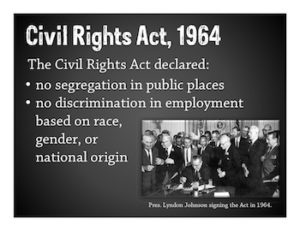
Lyndon Johnson signing the Bill
On this date in 1964, the Civil Rights Act was enacted into law in the United States. The first of three such pieces of legislation was an attempt to address the increasing demands of African Americans for equal rights.
President Lyndon Baines Johnson asked for and received the most comprehensive Civil Rights Act up to that time. The act specifically prohibited discrimination in voting, education, and public facilities. For the first time since the Supreme Court ruled on segregation in public schools in 1954, the federal government had a means of enforcing desegregation: Title VI of the act barred the use of federal funds for segregated programs and schools. In 1964, only two southern states (Tennessee and Texas) had more than 2% of their Black students enrolled in integrated schools. Because of Title VI, about 6% of the black students in the South were in integrated schools by the following year.
The Civil Rights Act of 1964 created an environment in which attitudes could change. It is not unrealistic to believe that once Blacks were allowed access to public accommodations, the myths and misconceptions would dissipate in time. Thus, the Civil Rights Act of 1964 laid the groundwork for an environment in which equality could flourish. The Civil Rights Act of 1964 contained 10 Titles. A brief description of each title is stated below.
Title I-Voting: required courts to give high priority to voting cases. It also provided for uniform voting tests and established a 6th-grade education as a requirement for literacy.
Title II-Public Accommodations: prohibited discrimination in public accommodations.
Title III- Desegregation of Public Facilities: authorized the Attorney General to file suits to desegregate public facilities.
Title IV- Desegregation of Public Education: authorized the Commissioner of Education to provide technical and financial assistance to help deal with problems resulting from desegregation. The Attorney General could institute suits in the name of the government on behalf of students or parents who were unable to bring suits.
Title V-Civil Rights Commission: made the Commission on Civil Rights a permanent body.
Title VI-Nondiscrimination in Federally Assisted Programs: prohibits discrimination by any programs or activities receiving financial assistance and authorizes action by the appropriate departments.Title VII- Equal Employment
Opportunity:
The Federal Equal Employment Opportunity Act was established to eliminate unlawful employment practices. Title Registration and Voting Statistics: directed the Secretary of Commerce to compile a list of registration and voting statistics in areas recommended by the Commission on Civil Rights.
Titles IX and X deal with procedures to follow appeals from federal court orders. It is ridiculous to think that the passage of the CRA of 1964 solved the problems of Blacks. It is impossible to change attitudes that have existed in American society for over 200 years with one or even a series of civil rights legislation.